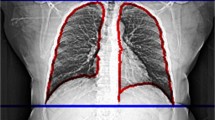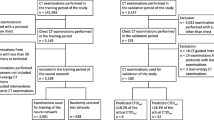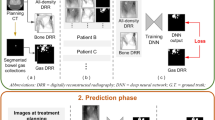Abstract
Excessive cephalocaudal anatomic (Z-axis) coverage can lead to unnecessary radiation exposure to a patient. In this study, an automated computing model was developed for identifying instances of potentially excessive Z-axis coverage with abdomen-pelvis examinations. Eight patient and imaging attributes including patient gender, age, height, weight, volume CT dose index (CTDIvol), dose length product (DLP), maximum abdomen width, and maximum abdomen thickness were used to build a feedforward neural network model to predict a target Z-axis coverage whether it is an excessive or non-excessive Z-axis coverage scans. 264 CT abdomen-pelvis exams were used to develop the model which is validated using 10-fold cross validation. The result showed that 244 out of 264 exams (92.4 %) correctly predicted Z-axis excessive coverage. The promising results indicate that this tool has the potential to be used for CT exams of the chest and colon, urography, and other site-specified CT studies having defined limited length.







Similar content being viewed by others
References
Yu L, Liu X, Leng S, Kofler JM, Ramirez-Giraldo JC, Qu M, Christner J, Fletcher JG, McCollough CH: Radiation dose reduction in computed tomography: techniques and future perspective. Imaging Med 1:65–84, 2009
Kalra MK, Maher MM, Toth TL, Kamath RS, Halpern EF, Saini S: Radiation from “extra” images acquired with abdominal and/or pelvic CT: effect of automatic tube current modulation1”. Radiology 232(2):409–414, 2004
Manduca A, Yu L, Trzasko JD, Khaylova N, Kofler JM, McCollough CM, Fletcher JG: Projection space denoising with bilateral filtering and CT noise modeling for dose reduction in CT. Med Phys 36(11):4911–4919, 2009
Szucs-Farkas Z, Verdun FR, von Allmen G, Mini RL, Vock P: Effect of X-ray tube parameters, iodine concentration, and patient size on image quality in pulmonary computed tomography angiography: a chest-phantom-study. Investig Radiol 43(6):374–381, 2008
Graser A, Johnson TR, Chandarana H, Macari M: Dual energy CT: preliminary observations and potential clinical applications in the abdomen. Eur Radiol 19(1):13–23, 2009
Liao EA, Quint LE, Goodsitt MM, Francis IR, Khalatbari S, Myles JD: Extra Z-axis coverage at CT imaging resulting in excess radiation dose: frequency, degree and contributory factors. J Comput Assist Tomogr 35(1):50, 2011
Wang S, Pavlicek W, Roberts CC, Langer SG, Zhang M, Hu M, Morin RL, Schueler BA, Wellnitz CV, Wu T: An automated DICOM database capable of arbitrary data mining (including radiation dose indicators) for quality monitoring. J Digit Imaging 24(2):223–233, 2011
Haibo H, Garcia EA: Learning from imbalanced data. IEEE Trans Knowl Data Eng 21(9):1263–1284, 2009
Sandberg IW: Nonlinear dynamical systems: feedforward neural network perspectives. John Wiley & Sons, 2001
Hall M, Frank E, Holmes G, Pfahringer B, Reutemann P, Witten IH: The WEKA data mining software: an update. ACM SIGKDD Explor Newsl 11(1):10–18, 2009
McCollough CH: Automated data mining of exposure information for dose management and patient safety initiatives in medical imaging. Radiology 264(2):322–324, 2012
Hara AK, Wellnitz CV, Paden RG, Pavlicek W, Sahani DV: Reducing body CT radiation dose: beyond just changing the numbers. Am J Roentgenol 201(1):33–40, 2013
Ikuta I, Warden GI, Andriole KP, Khorasani R, Sodickson A: Estimating patient dose from X-ray tube output metrics: automated measurement of patient size from CT images enables large-scale size-specific dose estimates. Radiology 270(2):472–480, 2014
Cheng PM, Vachon LA, Duddalwar VA: Automated pediatric abdominal effective diameter measurements versus age-predicted body size for normalization of CT dose. J Digit Imaging 26(6):1151–1155, 2013
Author information
Authors and Affiliations
Corresponding author
Rights and permissions
About this article
Cite this article
Zhang, M., Wellnitz, C., Cui, C. et al. Automated Detection of Z-Axis Coverage with Abdomen-Pelvis Computed Tomography Examinations. J Digit Imaging 28, 362–367 (2015). https://doi.org/10.1007/s10278-014-9743-7
Published:
Issue Date:
DOI: https://doi.org/10.1007/s10278-014-9743-7




